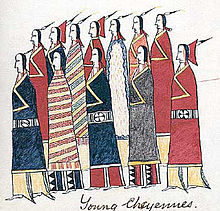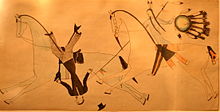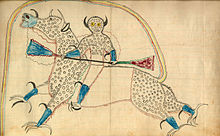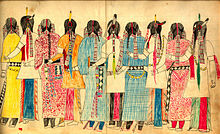- Ledger Art
-
Ledger Art ist die Bezeichnung für eine grafische Kunstrichtung von Prärie-Indianern, etwa zwischen 1865 und 1935. Es sind Zeichnungen und Malereien auf Papier mit Bleistift, Tinte, Buntstift oder Kreide, selten mit Wasserfarben koloriert. Der Name leitet sich von der englischen Bezeichnung für Konto-Bücher, den ledger books, ab. Für die Prärie-Indianer des 19. Jahrhunderts waren die Kontobücher der angloamerikanischen Siedler und der US-Army die erste und wichtigste Papierquelle. Es gibt indianische Künstler, die diese Kunstrichtung bis zum heutigen Tag pflegen.
Inhaltsverzeichnis
Historische Vorläufer
Ledger Art entwickelte sich aus der Malerei auf getrockneten Tierhäuten. Unter den Prärie-Indianern malten Frauen geometrische Designs und Männer gegenständliche Motive. Bemalt wurden oft Schilde, Tipis, Hemden, Leggins und Kleider. Häufigste Motive waren Heldentaten in Kriegen und auf der Jagd. [1]:138
Blütezeit
 Young Cheyennes, David Pendleton Oakerhater
Young Cheyennes, David Pendleton Oakerhater
Die berühmtesten Künstler der Ledger Art waren indianische Kriegsgefangene im Fort Marion in St. Augustine, Florida. 1874 im Red River Krieg bzw. Buffalo Krieg hatten Cheyenne, Kiowa, Comanche, Arapaho und Caddo Krieger gegen die US-Army gekämpft, um die letzte freie Büffelherde in der Region zu verteidigen und so ihre Unabhängigkeit zu sichern.[2]:12-14 Im rauhen Winter von 1874 bis 1875, waren viele Stammeslager gezwungen, sich zu ergeben. Die Anführer wurden ins Gefängnis nach Fort Marion gebracht.[2]:14 Von 1875 bis 1878 waren 71 Männer und eine Frau unter dem Kommando von Captain Richard Henry Pratt, der den Indianern Bildung in der weißen amerikanischen Kultur ermöglichte.[2]:25 Er versorgte die Indianer auch mit Bleistiften, Tinte, Kreiden, Wasserfarben und Papier.
26 der Gefangenen beschäftigten sich mit Zeichnen und Malerei.[2]:29 Einige der berühmtesten Künstler von Fort Marion waren: Paul Caryl Zotom (Kiowa), David Pendleton Oakerhater oder Making Medicine (Cheyenne), Tichtematse oder Squint Eyes (Cheyenne), Wohaw (Kiowa), Howling Wolf (Cheyenne), Etahdleuh Doanmoe (Kiowa), White Bear (Arapaho), Koba (Kiowa) und Bear’s Heart (Cheyenne). Tichtematse, Howling Wolf, White Bear und Koba zeichneten auch nach ihrer Entlassung aus dem Gefängnis.[2]:110
Ein besonders bekannter Vertreter der Ledger Art war Black Hawk. Er zeichnete 76 farbige Grafiken über das Lakota-Leben sowie über seine spirituellen Visionen. Seine Zeichnungen gelten als vollständigste Sammlung von Lakota-Kunst in der frühen Reservationszeit und als einzigartige historische und kulturelle Dokumente.[3]
Heute
Zahlreiche Indianer Künstler der Gegenwart produzieren Kunstwerke im Stil der Ledger Art. Dwayne Wilcox (Oglala Lakota) verwendet diesen Stil, um humorvolle Aspekte des gegenwärtigen Lebens der Lakota darzustellen. Arthur Amiotte (Oglala Lakota) nutzt Ledger Art auf seinen Collagen, wo er Texte, Fotografien, naturalistische Malerei und stilisierte Zeichnungen kombiniert.
Einzelnachweise
- ↑ Hansen, Emma I. Memory and Vision: Arts, Cultures, and Lives of Plains Indian People. Cody, WY: Buffalo Bill Historical Center, 2007. ISBN 0-295-98580-1
- ↑ a b c d e Szabo, Joyce M. Art from Fort Marion: The Silberman Collection. Norman: University of Oklahoma Press, 2007. ISBN 978-0-8061-3883-1
- ↑ Janet Catherine Berlo: Spirit Beings and Sun Dancers: Black Hawk's Vision of the Lakota World. New York, NY: George Braziller in association with the New York State Historical Association 2000, ISBN 0-8076-1465-3
Literatur
- Karen D. Petersen: Plains Indian Art from Fort Marion, University of Oklahoma Press, 1971
- J. Berlo, ed., Harry N. Abrams: Plains Indian Drawings 1865-1935: Pages from a Visual History, New York, 1976
- Greene, Candace S. Silver Horn: Master Illustrator of the Kiowas. Norman: University of Oklahoma Press, 2001. ISBN 0-8061-3307-4.
- Hansen, Emma I. Memory and Vision: Arts, Cultures, and Lives of Plains Indian People. Cody, WY: Buffalo Bill Historical Center, 2007. ISBN 0-295-98580-1.
- Swan, Daniel C. Peyote Religious Art: Symbols of Faith and Belief. Jackson: University of Mississippi Press, 1999. ISBN 1-57806-096-6.
- Szabo, Joyce M. Art from Fort Marion: The Silberman Collection. Norman: University of Oklahoma Press, 2007. ISBN 978-0-8061-3883-1.
Weblinks
 Commons: Ledger Art – Sammlung von Bildern, Videos und AudiodateienKategorien:
Commons: Ledger Art – Sammlung von Bildern, Videos und AudiodateienKategorien:- Kunst indigener Völker
- Indianische Kultur
Wikimedia Foundation.



